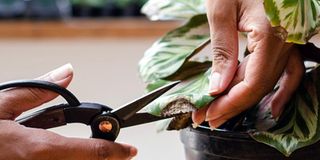Ways to protect house plants from pests

What you need to know:
Using clean soil and a clean pot gives your plant a chance to thrive and fight off pest infestation.
Having live plants inside the home has numerous benefits such as purifying the air, proving fresh herbs for the kitchen and improving the general aesthetics, among others. However, for them to thrive requires many conditions among which is protecting them from pests. Diana Kabagabe, an interior designer, shares ways one can prevent pests from attacking indoor plants.
Have check-up routines
Kabagabe says the best way to prevent house plant pests is to have a thorough check-up regularly that will help you identify any signs of pests.
“Identifying the problem earlier saves you from losing your plant and spending more money buying pesticides which sometimes fail to help,” she says.
In addition to identifying pest infestation regular check-up will also expose any other problems the plant has such as poor feeding due to less water or lack of light. Kabagabe urges plant owners to pay more attention to plants during the cold season because that is when pests tend to attack mostly.
“The pests hide under the leaves and stalks and if the plant has spent some time outside you need to change the flower pot to make sure that even the soil is free from pests. You can place your indoor plants on the veranda for some days before putting them in the house to make sure that there are no pests hiding,” she says
Check the soil and flower pots
To control indoor plant pests make sure the soil and flower pots are clean and the plants have enough water and fertilisers.
“Since we have varieties of plants, each has specific needs so it is a good idea to find out at the nursery or from other experts the best way to treat each plant. Some plants become weaker when they are infected and others change colours. Whatever signs these are usually indications that there is a problem which needs attention,” she says. Kabagabe notes that one significant indication that your plant is planted in poor soils is failure to produce the expected size of leaves instead of being bigger and wider they normally produce tiny leaves.
“Since soils are among the compulsory requirement for a healthy plant you have to respond accordingly, if the soil is inadequate add the required fertilisers to give it a boost. It is also advisable to change your soil after a certain period of time because sometimes these soils can form some pests after staying for too long,” she advises.
To be on a safe side, Kabagabe recommends getting a clean pot and clean soil when transplanting your seedling. “Wash it yourself and keep it dry before putting the soil and the plant,” she says.
Clean plants
Kabagabe says keeping your plants clean is one sure way of preventing pest infestation.
“Do not allow dust to settle on your plants because it clogs the pores of plant leaves, making it difficult for the plant to breathe. In addition, dust filters sunlight before it reaches the plant, decreasing the amount of photosynthesis the plant can undertake. Dust is also a carrier of spider mites and other insect pests which can contaminate the plant. Make sure that you look for required pesticides to clean your plant, while cleaning you can also spray to kill any pests that might have already attacked the plant,” she advises.
In case you have no available pesticide at the moment, Kabagabe says one can use clean plain water to clean.




